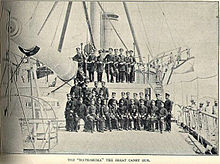


The Canet guns were a series of weapon systems developed by the French engineer Gustave Canet (1846–1908), who worked as an engineer from 1872 to 1881 for the London Ordnance Works, then for Forges et Chantiers de la Méditerranée, and from 1897 to 1907 for Schneider et Cie of Le Creusot.
320 mm naval guns

Canet developed a 12.6 in (32 cm) 38 cal naval gun, an extremely powerful weapon for its time, specifically for the export market. The gun was first selected by the Spanish Navy in 1884 as part of a large naval expansion program which called for six new battleships. The Spanish armaments firm Hontoria obtained a manufacturing license to produce the weapon, but due to budgetary reasons, only one vessel, the Pelayo, was completed.
Canet was more successful in sales to the Empire of Japan, when the gun was selected by the French military advisor and naval architect Louis-Émile Bertin as the main battery of the Matsushima-class cruiser, new type of cruiser he had designed in 1887. The usage was consistent with the Jeune École philosophy, which advocated placing overwhelming firepower (strong guns, torpedoes) on relatively small ships. This philosophy was of great interest to the Imperial Japanese Navy, which lacked the resources at the time to purchase modern pre-dreadnought battleships.
The guns supplied to Japan equipped the cruisers Matsushima, Itsukushima, and Hashidate. Each gun weighed 67 tons, and had a barrel 12 metres (39 ft) long, firing a 112 cm (44 in) long projectile with weight of 350 kg (770 lb) (or 449 kg (990 lb) high explosive) for an effective range of 8,000 metres (26,000 ft).
The guns proved only marginally successful during the First Sino-Japanese War, due to a slow rate of fire, and numerous mechanical problems. The guns could not be aimed abeam, as their weight would cause the ship to roll over when fired. In combat, gunners were able to fire only around one shot per hour due to the time it took to reload.
Other guns



Canet is also known for developing the Schneider-Canet gun system for 75 mm iron BL mountain guns, and rapid-fire 120 mm and 152 mm guns.
| Model | Type | Country |
|---|---|---|
| 75mm 50 caliber Pattern 1892 | Naval gun | |
| Canon de 75 modèle 1905 Schneider | Field gun | |
| Canon de 75 mm Modèle 1907 Schneider-Canet | Mountain gun | |
| Canon de 100 mm Modèle 1891 | Naval gun | |
| 120mm 45 caliber Pattern 1892 | Naval gun | |
| Obusier de 120 mm C mle 1897 Schneider-Canet | Howitzer | |
| 120 mm Schneider-Canet M1897 long gun | Siege gun | |
| Peigné-Canet-Schneider mle 1897 gun carriage | Siege gun | |
| Obusier de 15 cm TR Schneider-Canet-du-Bocage | Howitzer | |
| 152 mm 45 caliber Pattern 1892 | Naval gun | |
| 203mm 45 caliber Pattern 1892 | Naval gun |
References
- Roksund, Jeune École
- Brooke, Warships for Export pp. 58–60
- "Japanese 12.6"/38 (32 cm) Canet". navweaps.com. 2006-03-16.
- Wright, Richard N. J. (2000), The Chinese Steam Navy 1862–1945, London: Chatham Publishing, p. 92
- Kosar, Franz, A pocket history of artillery: Light fieldguns, Allen Lane, London 1974, ISBN 0711004854
Bibliography
- Brooke, Peter (1999). Warships for export: Armstrong warships 1867–1927. Gravesend: World ship society. ISBN 0-905617-89-4.
- Roksund, Arne (2007). The Jeune École: The strategy of the weak. Leiden: Brill. ISBN 9789004157231.
External links
| Small arms | ||
|---|---|---|
| Machine guns | ||
| Cannons | ||
| Warships | ||
| Ammunition | ||
| Systems | ||
| Operational usage | ||
